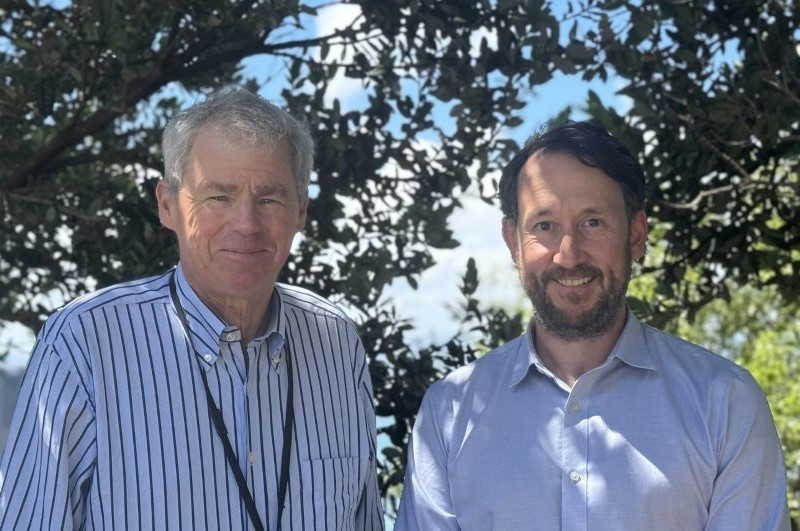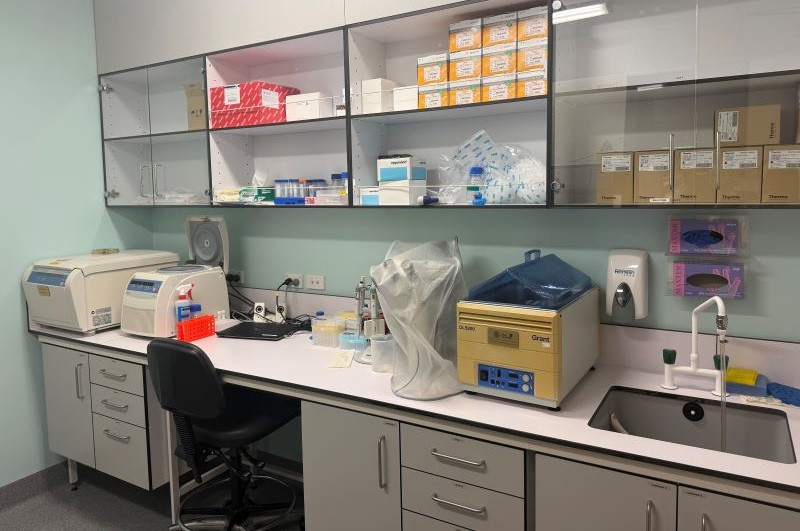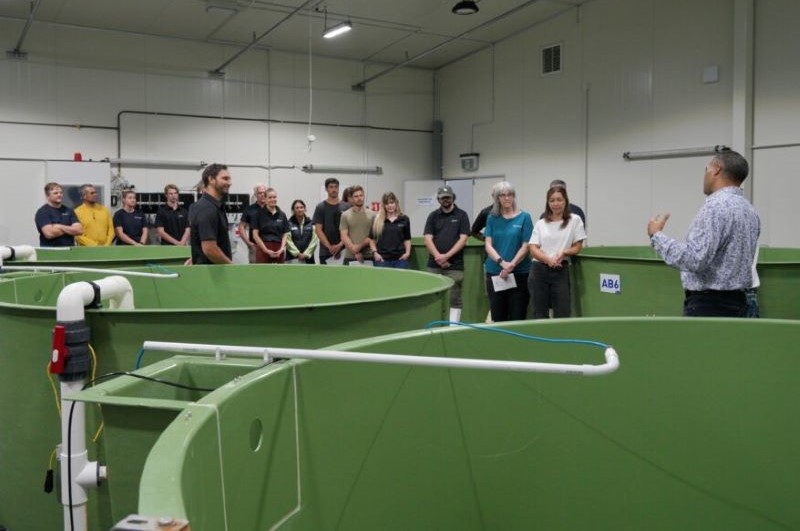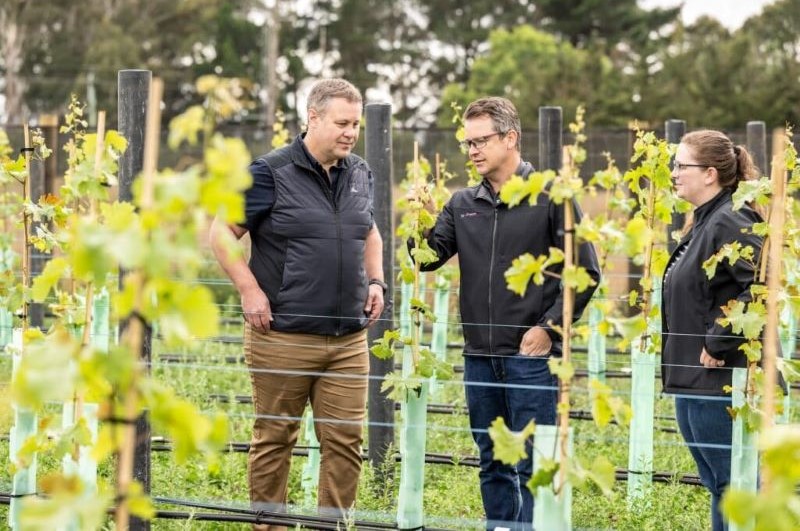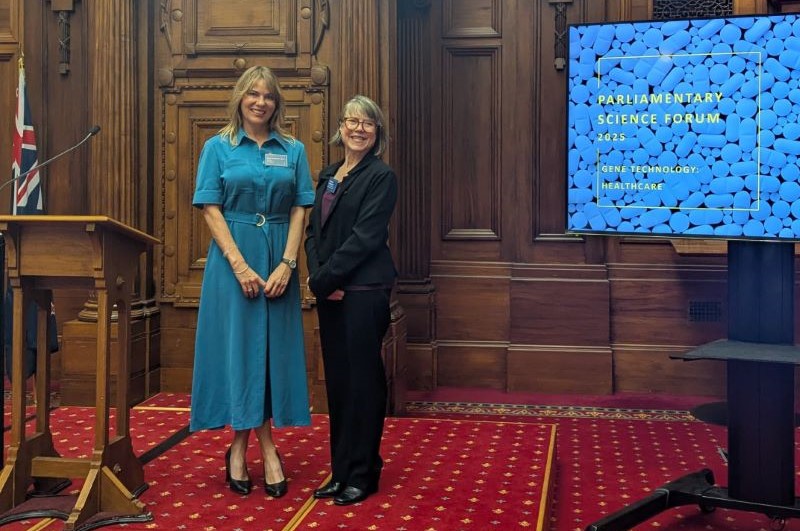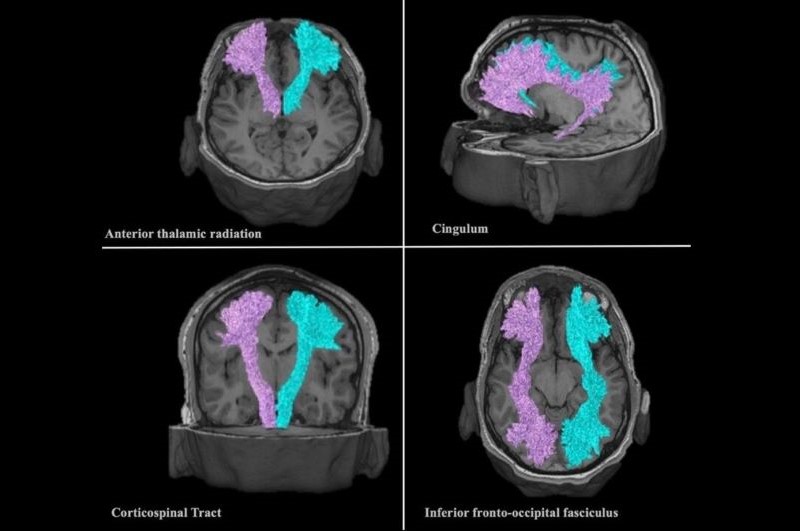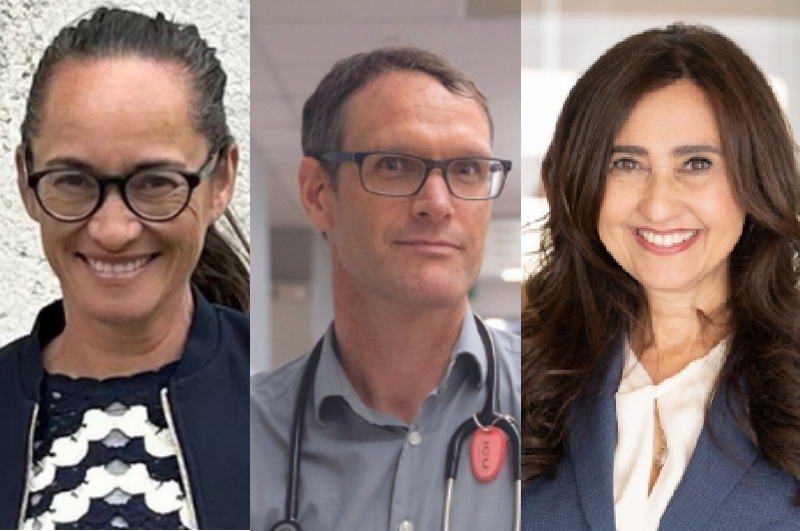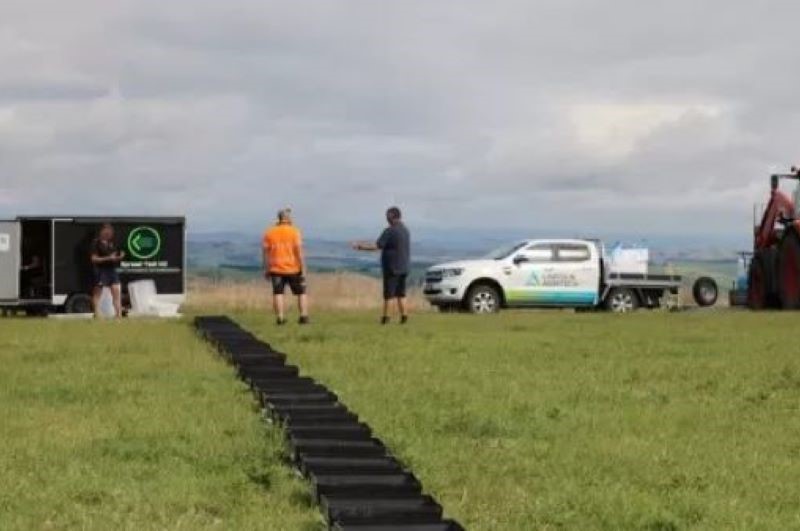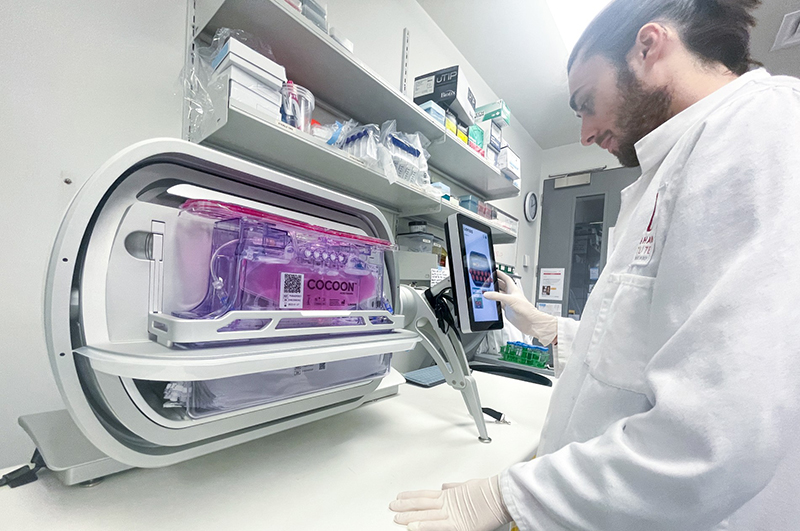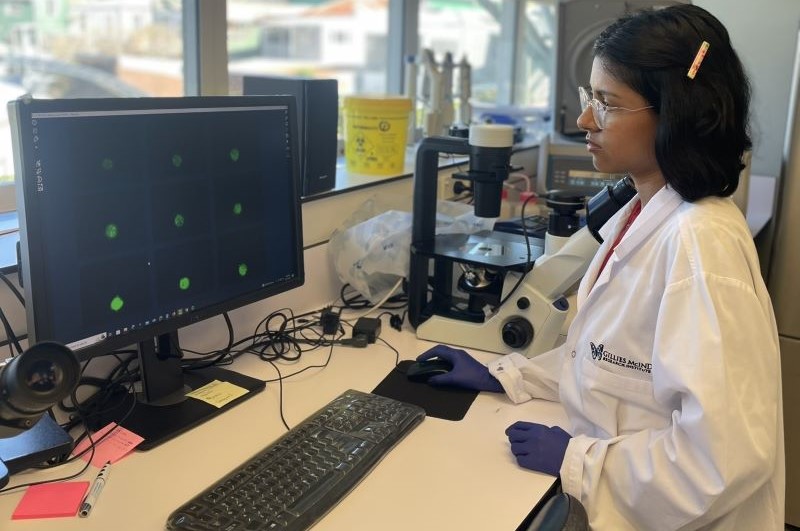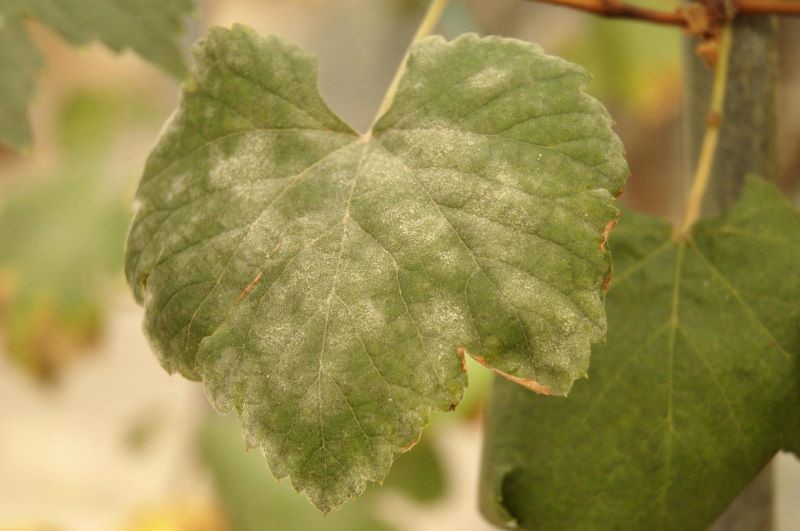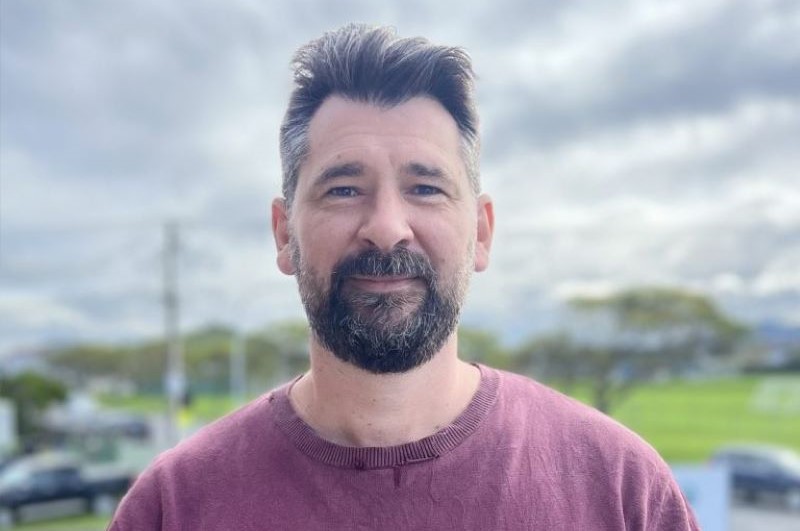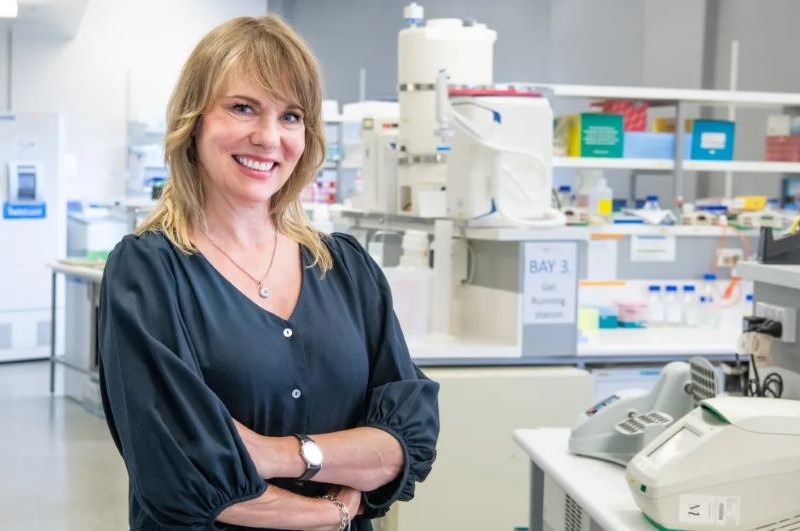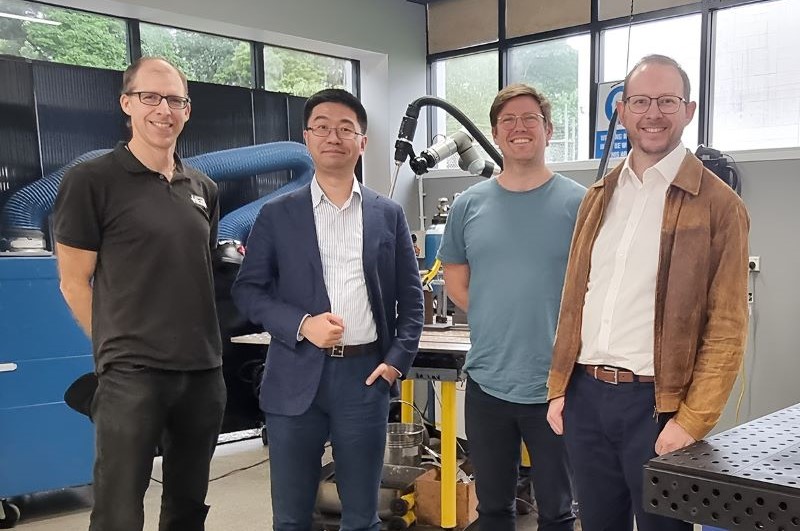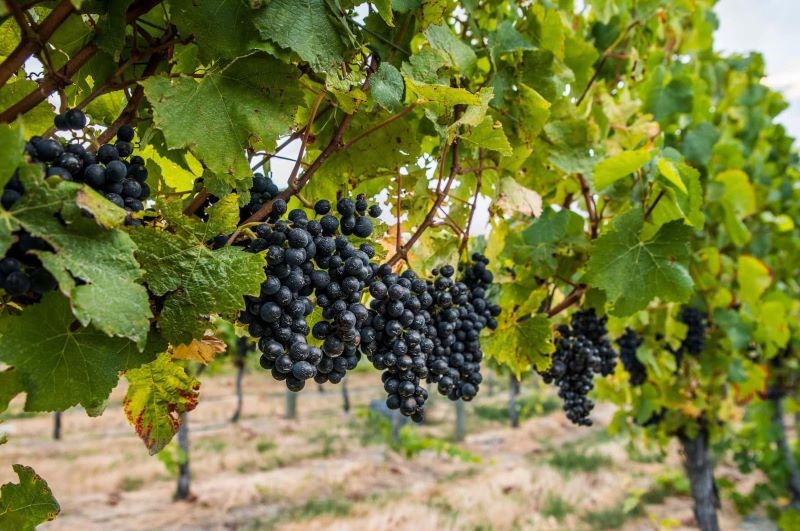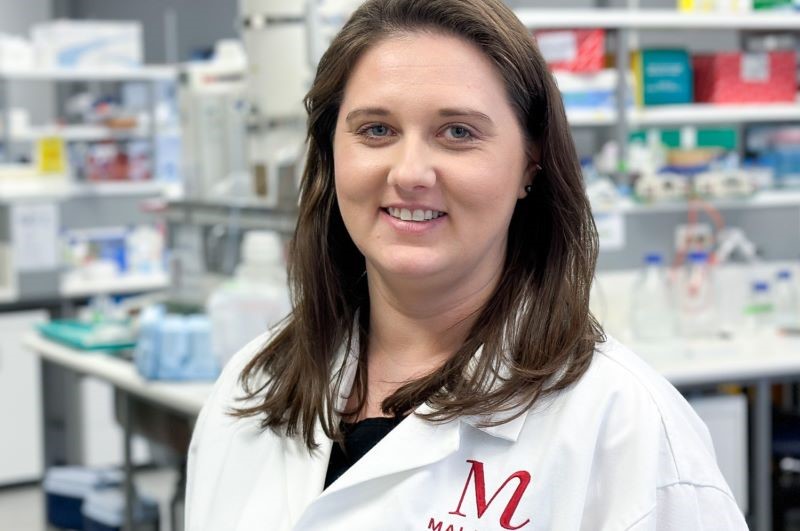News
Archives: 2024 | 2023 | 2022 | 2021 | 2020 | 2019 | 2018 | 2017
News
Mātai: Prostate cancer funding helps 100 Gisborne-Tairāwhiti men
May 2025: Around 100 men in Gisborne-Tairawhiti have benefited so far from funding, from philanthropic contributions and from the Perpetual Guardian Foundation's Medical Research Fund, that supports an advanced approach to prostate cancer diagnosis.
Prostate cancer is the most commonly diagnosed cancer in New Zealand, and there are significant disparities in terms of diagnosis, treatment and outcomes. The funding pathway has so far enabled more accurate scans of the 100 men in this district and is part of a joint funding effort that is helping to pave the way to potentially save thousands of lives.
The ongoing project at the non-profit Mātai Medical Research Institute in Gisborne-Tairāwhiti uses advanced MRI techniques to improve how prostate cancer is diagnosed.
“Men living in rural locations face higher mortality rates from prostate cancer and have lower screening rates, less intensive diagnostics, longer wait times, and later diagnoses,” says head of radiology Te Whatu Ora Tairawhiti and Matai clinical lead Dr Daniel Cornfeld.
Dr Daniel Cornfeld. Photo: Mātai Medical Research Institute.
The role of TTW in seed banking
May 2025: In this article about Te Tira Whakamātaki's role in seed banking, M. Bissett writes about Aotearoa New Zealand's struggling seed-banking initiatives, and the importance of a seed conservation strategy.
"Did you know the rarest plant in the world is right here in Aotearoa? There's only one kaikōmako manawatāwhi left in the wild and it's on Manawatāwhi Island. Of course, that's not a Guiness World Record to be proud of. Aotearoa has over 2,500 plants and more than 80% are endemic. But due to deforestation, agriculture, human activity, and the taking of seeds and plants to put in gardens, more than 15% of our plants are threatened and 30% more are at risk. That's a massive problem.
"One way to save these taonga is through seed banking. Seed banking is a process of safeguarding plants in the event of a catastrophe or disease that could threaten the plants, and seed banks are the purpose-built storage facilities that house those seeds, keeping them safe and ready to germinate in case the plant dies out in the wild, or there is a need to improve genetic diversity in a population because of disease or a catastrophe including climate change."
Kōtukutuku flower. Photo: Te Tira Whakamātaki.
Lincoln Agritech tackles apple challenges with European collaboration
May 2025: New Zealand's horticultural sector, particularly its globally significant apple industry, faces ongoing challenges in maintaining fruit health and quality. Addressing these concerns often requires new approaches and strategic partnerships, such as those that Lincoln Agritech has formed within the STELLA project.
STELLA research uses advanced digital technologies to develop and implement enhanced plant health management, including early disease detection, comprehensive territory surveillance, and effective phytosanitary measures. When preparing the project proposal, STELLA contacted New Zealand colleagues who also work in this digital area. As a result, the project now includes apple production, creating a win-win situation for the European project consortium and New Zealand's horticultural research and development efforts.
For Lincoln Agritech's researchers, the project has established a valuable collaboration with international researchers at leading European universities and research organisations.
Article author and Lincoln Agritech Principal Science Advisor Dr Armin Werner investigates an apple orchard. Photo: Lincoln Agritech.
Thousands give feedback in WSP and BRANZ 'loo review'
May 2025: Thousands of people have had their say on the state of public and commercial bathrooms, with results from WSP and the Building Research Association of New Zealand's (BRANZ) 'loo review' now in - and the findings offer strong evidence for change.
More than 3,000 people took part in the survey, part of a WSP study commissioned by BRANZ that also included a literature review and targeted stakeholder consultation. The aim was to assess whether bathrooms in public and commercial buildings - such as libraries, sports centres, museums and eateries - are meeting people's needs.
And, for many, they're not.
One in five respondents said public bathrooms don't meet their needs, a figure that jumps to nearly half for those with a disability.
WSP team leader for human factors and social sciences Leoni McKelvey says the feedback paints a clear picture of what's working - and what isn't.
Obviously a topic that has piqued the public's attention - thousands took part in the 'loo review'. Photo: WSP.
Cawthron: Stories, not just statistics, will save environment
May 2025: Cawthron Institute Freshwater Ecologist Dr Kati Doehring writes about the power of scientific story telling in this opinion article from the institute.
"Scientific data is essential for understanding the state of our environment, but numbers alone rarely move people to action. To truly connect with the public and spark meaningful change, we must bring data to life through storytelling.
"I have seen first-hand how a well-told story can shift conversations, open minds, and bridge the gap between complex science and public understanding. Data tells us what is happening, but stories help us understand why it matters. Take our rivers, for example. Water quality statistics can be confronting, yet impersonal. When I hear the story of a river that once supported thriving ecosystems and sustained whānau, now degraded by pollution or climate pressures, I do not just see a number, I feel the loss. That emotional connection is what turns information into a call to action.
"I am heartened to see the government embracing this approach in their environmental reporting over the last couple of years."
Dr Dr Kati Doehring. Photo: Cawthron Institute.
Motu: Putting children at the centre seminar
May 2025: Join Motu Fellow Jaimie Monk for a Motu Public Policy Seminar on Wednesday, 28 May 2025, 12.00pm-1.30pm, where Jamie will present findings from her latest report, drawing on data from the Growing Up in New Zealand study to examine children's behavioural development. Her presentation will explore:
- how family income affects children at different stages of development,
- the impact of technology use on New Zealand children's behavioural development,
- the role of housing in shaping developmental outcomes.
The presentation will be followed by a panel discussion and audience questions. The panel will be chaired by Motu Senior Fellow Arthur Grimes, and feature:
- Dr Jin Russell, Clinical Chief Advisor: Child and Youth, Manatū Hauora - Ministry of Health
- Hannah Kerr, Director, Child Wellbeing and Poverty Reduction Group, Ministry of Social Development
- Jacqui Southey, Research Director, Save the Children New Zealand
Photo: Getty Images, UnSplash.
Cawthron & iwi partners secure support for seaweed research
May 2025: Cawthron Institute and iwi/hapū research partners are celebrating the success of two mātauranga Māori focused research projects that have secured funding through the 2025 Vision Mātauranga Capability Fund (VMCF), administered by the Ministry of Business, Innovation and Employment (MBIE).
The first project, in partnership with Te Rūnanga o Kaikōura, focuses on karengo (a type of edible red seaweed closely related to Japanese nori) found along the Kaikōura coastline. Revered by Māori for generations as a nutritious delicacy and environmental indicator, karengo is now the subject of an innovative research initiative blending mātauranga Māori and ecological science.
The second collaborative project with the Whangārei Harbour Kaitiaki Roopū will enhance collective understanding about increasing rimurimu (seaweed) strandings along the Whangārei coast, which are affecting coastal ecosystems and hapū wellbeing. It will also investigate opportunities arising from these events.
Dr Tom Wheeler with seaweed samples in Cawthron Institute's Whakatū Nelson laboratories. Photo: Cawthron Institute.
Malaghan: Asking the age-old question
May 2025: Getting older. Everyone does it, some more reluctantly than others. Yet despite it being an intrinsic part of the human experience, when it comes to understanding how age affects the body's ability to fight disease, very little attention has been paid. Dr Michelle Linterman hopes to change that.
“Age is the biggest risk factor for any disease,” says Michelle from her office at the Malaghan where she's the institute's newest laboratory head. Having recently returned to New Zealand from the Babraham Institute in Cambridge, UK, she's one of the relatively small number of scientists around the world actively looking into the ageing immune system and how to improve the way it responds to vaccination.
“It doesn't matter what other complications you may have, when it comes to health the impact of ageing trumps everything. Almost everything has an intersection with age and, in research, for the most part, it gets ignored.”
It's now well understood that the diversity between people plays an important role in clinical outcomes. Because differences in things like sex and ethnicity exist, treatments and drugs need to take account these subtle biological, chemical, and physical differences to make effective therapies and cures.
Dr Michelle Linterman. Photo: Malaghan Institute of Medical Research.
Malaghan: Brain and immunity
May 2025: According to Professor Kjesten Wiig, Director of the Malaghan Institute, the future of brain research lies in neuroimmunology. As a trained neuroscientist, she explores how this fast-rising field could transform how we understand neurological disorders like Alzheimer's, Parkinson's and motor neuron disease.
"Few conditions inspire more dread than the creeping shadow of neurodegenerative disease. At times, it feels almost taboo to talk about, perhaps because it touches on something deeper than physical decline. We fear the loss of our mental faculty because it threatens the very core of who we are; our memories, our relationships, our sense of self. What makes neurodegenerative disease more unsettling is just how little we understand about these diseases and how few tools we have to stop them.
"So how can we protect our brains from decline and retain our health for longer? I believe the answer lies in our immune system.
"The brain is a unique organ, isolated from the rest of the body through the blood-brain barrier...”
Professor Kjesten Wiig. Photo: Malaghan Institute of Medical Research.
Lincoln Agritech: Researchers & iwi gather for project
May 2025: Waikato-Tainui and Ngāti Korokī Kahukura formally welcomed and acknowledged the Emerging Climatic Pressures research group last month with a mihi whakatau at Mystery Creek.
Much of the research programme, which is investigating the effects of rising atmospheric CO2 levels on freshwater systems, particularly the Waikato River, takes place in their rohe.
“We are really interested in any and all interactions with our awa, which we see as our tupuna, our ancestor,” says Merekara Warrington, a Ngāti Korokī Kahukura trustee.
“We want to make sure that the awa is being respected, and that the research brings benefit back to the river. We are really there as kaitiaki, or guardians.”
Roland Stenger, principal scientist of Lincoln Agritech’s Environmental Research team, provided a brief overview of the programme. He highlighted that changes in water and sediment chemistry will affect the plants and animals living in the river, which are critically important to mana whenua.
Iwi representatives and Lincoln Agritech scientists are looking forward to a similar event in a year's time to discuss interim results of the research. Photo: Lincoln Agritech.
Connections 53 eNewsletter out now
April 2025: Another bumper issue of the IRANZ newsletter is out now. It's chock full of the latest independent science research news from around Aotearoa New Zealand.
Three IRANZ researchers elected as Royal Society Te Apārangi Fellows
Mātai: Understanding brain pulses
Estendart: New study explores non-surgical eye treatment for vision loss
Gillies McIndoe opens doors to translational research and collaboration
BRANZ study reveals rising indoor summer temps in Kiwi homes
Motu: New modelling reveals impact of Trump's 'Liberation Day' tariffs
WSP: Level crossing driver behaviour
Parliamentary Science Forum: Our blue economy
Cawthron: Action needed to prevent extinction of pāteke on Great Barrier
Bragato: Exploring new ways to grow grapes
Lincoln Agritech: Study reveals drawback of blended fertiliser
Aqualinc: Land use restrictions eased
. . . And much more.
A new Cawthron study has revealed that the remnant population of the endangered pāteke/brown teal on Aotea Great Barrier Island is at serious risk of extinction within the next century. Photo: Louise Thomas.
IRANZ April news briefs
April 2025: Follow the link for more details on the April 2025 news briefs from our Independent Research Organisations.
- Motu: Winners at the 34th Australia New Zealand Econometric Study Group Meeting
- ERL completes dermal irritation study for promising skin treatment
- Malaghan's Kjesten Wiig: Bringing life-changing treatments to life
- Kevin Jenkins appointed to BRANZ Board
- Bragato: Invitation for research proposals
- Cawthron: New Westpac report highlights huge potential of Aotearoa New Zealand's blue economy
- Malaghan visiting researcher: Dr Ian Myles
- Malaghan visiting researcher: Dr Nicholas van Panhuys
- Bragato: Grape Days 2025
- New Motu research helps align different life satisfaction scales
- ...and much more.
Professor Graham Le Gros and Dr Nicholas van Panhuys. Since completing his PhD at the Malaghan Institute in 2007, Dr Nicholas van Panhuys has built an international career researching how allergies develop. He returned to the institute to share his latest findings. Photo: Malaghan Research Institute.
Gillies McIndoe opens doors to researchers
April 2025: The Gillies McIndoe Research Institute in Wellington offers access to specialised lab space, histology services, and a large tissue and cell bank — supporting researchers and biotech innovators working to translate early-stage discoveries into practical outcomes.
Located in Newtown, the Institute's Translational Research Services cater to both academic and commercial users, helping navigate common barriers in development, including limited lab facilities and access to patient-derived materials.
Facilities include PC2-certified labs, a lentivirus-compliant tissue culture room, and shared equipment such as an Incucyte, confocal microscope, and ultra-low temperature storage. A histology suite supports work in biomarker discovery and pharmaceutical research, including H&E, IHC, FISH, ISH, and access to proteomics and metabolomics.
Researchers can also access a wide-ranging tissue and cell bank, with services including tissue digestion and biobanking under approved ethics.
Available on a fee-for-service or collaborative basis, these services help bridge the gap between lab research and real-world application — supporting innovation and enabling new partnerships across the research and biotech sectors.
Lentivirus-compliant tissue culture room. Photo: Gillies McIndoe.
WSP adds to triaxial testing fleet
April 2025: WSP has expanded its national fleet of soil testing technology with the addition of a new automatic static triaxial testing machine in its Petone research lab.
The machine, which arrived from Italy last year, is designed to test the strength of slope materials and their properties. It measures the energy at which soil and aggregates will shear under pressure - letting engineers improve the stability of slopes, retaining walls, and other civil engineering structures.
WSP Petone-based team leader for testing services Zac Francis says the new triaxial machine is a big leap forward in WSP Research's triaxial testing capabilities.
"It's much larger and more sophisticated than anything we've had before, allowing us to work more efficiently, test to additional standards and provide more detailed and accurate results.”
The new machine joins a fleet of fifteen triaxial testing machines that WSP operates across its Wellington, Hamilton, and Auckland labs. While other WSP labs have similar machines, the new one in Petone can handle non-conventional sample sizes and test large aggregate material such as basecourse and subbase.
Petone research laboratory. Photo: WSP.
ERL completes dermal irritation study for promising skin treatment
April 2025: Estendart Research (ERL) recently completed a dermal irritation study in rats, investigating a topical non-antimicrobial product designed to treat superficial skin pyodermas. The study marks an important step in evaluating the product's safety before it can progress to human clinical trials.
Preclinical research like this is essential in the early development of new drugs and medical devices, particularly in areas where artificial intelligence cannot yet replace laboratory testing. These studies provide vital data on how a treatment interacts with the body (pharmacodynamics) and how the body processes it (pharmacokinetics).
At ERL, preclinical studies are a core part of their work, supporting clients in identifying safe starting doses and assessing the potential toxicity of new treatments. By ensuring products meet strict safety standards, these studies help lay the foundation for effective and ethical human trials.
This latest research contributes to the development of innovative, non-antibiotic options for managing common skin conditions, potentially reducing reliance on antimicrobial treatments and helping to combat antibiotic resistance.
Photo: Estendart Research.
BRANZ: Balancing the quality/affordability equation
April 2025: BRANZ CEO Claire Falck identifies the need to balance affordability and quality as among the most pressing challenges facing the sector in 2025.
"Often when we start talking about improving quality standards in the building industry, the default response is 'but what about affordability?' - the concern being that the two concepts are mutually exclusive or 'quality equals expensive'.
"It's not an unreasonable concern, but it is an inaccurate assumption, and I don't think New Zealand has to - or should - choose between the two.
"Every year, we're confronted with news of a range of building flaws and failures. Already in 2025, we've seen stories emerge about overheating townhouses, new weathertightness issues in apartment complexes, blatant non-compliant practices and multi-million-dollar repair costs. There's no question that, collectively, the sector needs to do better because the costs to building and homeowners of putting things right will always far outweigh the cost of getting them right first time."
BRANZ CEO Claire Falck. Photo: BRANZ.
WSP: Level crossing driver behaviour
April 2025: Following WSP's groundbreaking research into the impact of level crossing infrastructure on driver behaviour, a second stage of research has shed new light on how road design can influence safety at these critical intersections.
Between 2010 and 2020, there were fifty-two fatal or serious injury incidents at level crossings across Aotearoa New Zealand. Many of these were at passive crossings, where the only control measures were "Stop" signs.
WSP Research's Joel Burton, who led the study on behalf of KiwiRail, says the first stage of WSP's research highlighted the surprising ways in which infrastructure could shape driver decisions. It found that many drivers simply rolled through Stop signs or failed to properly check for oncoming trains, even when signs were clearly visible. This behaviour was especially prevalent at passive level crossings with poor visibility and no active controls.
“With a clear need to better understand the factors that influence driver behaviour, the second stage of our research, carried out between July 2023 and April 2024, took a more hands-on approach to observe and quantify these behaviours," says Joel.
Typical level crossing signs in New Zealand. Photo: WSP.
Estendart: Newborn calf vaccination pilot study offers hope for early disease prevention
April 2025: Estendart Research (ERL) has completed a two-part pilot study testing a novel vaccine in newborn calves, aiming to improve early disease prevention in calf sheds. Vaccinating calves at birth could significantly reduce the risk of disease spreading during this vulnerable stage.
Calves typically rely on passive immunity passed on from their dams (mothers), which are often vaccinated to protect both themselves and their offspring. However, when cows are unvaccinated or calves receive powdered colostrum instead of natural colostrum, the transfer of immunity may be insufficient. This leaves young calves exposed to a range of fast-spreading, potentially fatal zoonotic diseases, which are costly for farmers to manage.
The pilot study required close observation of heavily pregnant cows, with researchers monitoring around the clock to identify and treat newborns immediately after birth. Once born, each calf was drafted, vaccinated, and sampled for ongoing analysis.
The promising approach trialled by ERL could offer a valuable tool to improve calf health and protect herd wellbeing, especially in situations where natural immunity is compromised.
A calf in the vaccine pilot study takes a rest while being monitored. Photo: Estendart.
Mātai: Understanding brain pulses
April 2025: Groundbreaking research involving Mātai Medical Research Institute and New Zealand collaborators has been featured in a special edition of the UK Royal Society's Interface Focus journal. The issue, emerging from the interdisciplinary Pulsing Brain meeting co-chaired by Associate Professor Samantha Holdsworth (Mātai and University of Auckland), explores how the brain subtly moves with every heartbeat — a phenomenon that may be key to understanding brain health, ageing, and disease.
The lead perspective paper outlines how non-invasive imaging technologies such as MRI, ultrasound, and mathematical modelling are shedding new light on brain fluid dynamics and tissue motion. A standout innovation is amplified MRI (aMRI), pioneered by Mātai, which reveals micro-movements in the brain.
Mātai's collaborative studies also showed that even mild exercise changes brain motion, with implications for understanding concussion and long-term neurological health. Another paper challenged assumptions about brain ageing, showing blood vessel stiffness doesn't increase with age in healthy people.
Visualising brain blood flow with 4D flow MRI: This image shows how major brain arteries are tracked in 3D. The technique reveals how heartbeat pressure waves move through vessels, offering insight into vascular health. Image: Sergio Dempsey (Auckland Bioengineering Institute).
Estendart: New study explores safer, non-surgical eye treatment for vision loss
April 2025: Vision impairment remains a significant global health challenge, with millions affected by conditions such as age-related macular degeneration, diabetic retinopathy, and glaucoma. While several treatment options exist, many have limitations in both effectiveness and long-term outcomes.
A key challenge is delivering medication to the back of the eye, where the retina and macula are located. Current treatments often rely on frequent injections or even subretinal surgery — invasive methods that carry risks and complications for patients.
Estendart Research (ERL) has recently completed a pilot study investigating a promising alternative: a novel, non-surgical suprachoroidal delivery technology designed to administer next-generation retinal treatments more safely and effectively. This approach aims to improve how therapies reach the affected areas in the posterior segment of the eye, potentially reducing the need for invasive procedures.
ERL's research represents a step forward in developing safer, more efficient treatments for vision loss and could play a key role in improving outcomes for patients living with serious eye diseases.
Photo: Eren Li, Pexels.
Parliamentary Science Forum: Our blue economy
April 2025: The third event in 2025's Parliamentary Science Forum was held on 1 April. MPs learnt about how aquaculture (fish farming) can feed our growing world. Dr Suzy Black, Plant & Food Research, spoke about farming fish in mobile enclosures and Dr Patrick Cahill, Cawthron Research Institute, spoke about a variety of aquaculture techniques for shellfish and seaweeds.
Patrick, Research Scientist and Marine Biosecurity Team Leader at Cawthron, discussed the potential of aquaculture to grow the New Zealand economy.
"We are currently realising less than 5% of the sustainable biophysical potential for aquaculture in New Zealand. A prosperous, resilient future aquaculture sector calls for diversity and sustainability, with low trophic aquaculture an important component. Low trophic aquaculture is the farming of aquatic primary consumers (e.g., seaweeds) and aquatic primary producers (e.g., shellfish). New Zealand are world-leaders in low trophic aquaculture, exemplified by our iconic Greenshell mussel farming sector. Low trophic species are inherently geared toward high productivity, and by farming the right species we can deliver high value products to domestic and international consumers."
Dr Suzy Black (left) and Dr Patrick Cahill (right) answer MPs' questions with event host Dr Parmjeet Parmar MP (centre). Photo: RSNZ.
Motu: New modelling reveals full impact of Trump's 'Liberation Day' tariffs - with the US hit hardest
April 2025: Wondering about the impact of the Trump tariffs on New Zealand and other countries?
Motu Economic & Public Policy Research Senior Fellow Professor Niven Winchester has estimated changes in countries GDP due to US reciprocal tariffs with the results published in The Conversation magazine. He models two scenarios - GDP impacts with and without retaliatory tariffs by countries.
Under the model where countries respond with equivalent tariffs on US goods - "Some nations gain from the trade war. Typically, these face relatively low US tariffs (and consequently also impose relatively low tariffs on US goods). New Zealand (0.29%) and Brazil (0.28%) experience the largest increases in GDP. New Zealand households are better off by $397 per year.
"The tariffs decrease US GDP by $149 billion (0.49%) because the tariffs increase production costs and consumer prices in the US...At the same time, retaliation leads to a worse outcome for the US.
"Previous tariff announcements by the Trump administration dropped sand into the cogs of international trade. The reciprocal tariffs throw a spanner into the works. Ultimately, the US may face the largest damages."
US President Donald Trump announces “Liberation Day” tariffs.
Cawthron: Helping snapper beat the heat
April 2025: Scientists at Cawthron and Plant & Food Research in Whakatū Nelson are collaborating to understand how snapper (tāmure) cope with temperature extremes. The work is part of the MBIE-funded Climate Adapted Finfish research programme, led by Cawthron, which aims to help key species thrive in a changing climate.
More than 1,000 juvenile snapper were recently transferred from Plant & Food Research at Port Nelson to Cawthron's Aquaculture Park in Glenduan. There, they'll be closely monitored under different temperature conditions to assess how they perform.
Programme leader Dr Jane Symonds, Cawthron senior aquaculture scientist, says the trials will help inform future breeding. “We've been running these kinds of studies with salmon for quite some time and recently discovered that thermotolerance is a heritable trait in King salmon - which is great news for future-proofing the species. But we haven't yet done this work for other high-interest species like snapper.”
The research will have implications for aquaculture, wild fisheries, and biodiversity, providing critical insights into how marine species may adapt to climate change.
A group of researchers and technicians from Plant & Food Research and Cawthron Institute gather at Cawthron's Finfish Research Centre for a blessing of the snapper/tāmure. Photo: Cawthron.
Sauvignon Blanc 2.0: Building the future of resilient vines
April 2025: Bragato Research Institute's Sauvignon Blanc 2.0 Programme is propelling New Zealand's wine industry into the future, aiming to produce the next generation of resilient grapevines. Now three years into its decade-long timeline, the programme combines cutting-edge science, technology, and strategic investment to help vineyards adapt to climate and disease pressures while maintaining competitiveness.
In 2024, researchers successfully generated over 6,000 unique Sauvignon Blanc clones through controlled stress techniques that trigger natural genetic changes. Each vine is digitally tracked from lab to nursery to vineyard, where a new quarantine-managed research site in Lincoln has been established. With survival rates over 97%, the young vines are now poised for the next phase of selection.
DNA extraction and sequencing tools have been scaled up, and bioinformatics workflows are being used to identify promising traits like disease tolerance and drought resistance. A key innovation is the new AI Blackbird robot, capable of scanning hundreds of leaves daily to detect powdery mildew resistance - potentially reducing spray use.
Inspecting plants in the new research vineyard. From left to right: Ross Wise, Darrell Lizamore, and Amy Hill. Photo: Bragato Research Institute.
New Motu research helps align different life satisfaction scales
April 2025: A new working paper from Motu Economic and Public Policy Research offers a practical solution for wellbeing researchers grappling with incompatible life satisfaction scales. Motu researchers Amelia Blamey and Arthur Grimes have developed a distributional matching method to harmonise life satisfaction scores collected on different scales, preserving the relative distribution of responses while respecting their ordinal nature.
The method is demonstrated using two concurrent Stats NZ surveys - one with an 11-point scale and the other with a 5-point scale. The researchers identified an optimal mapping from the 11-point to the 5-point scale as follows: scores of 0-2 map to 1, 3-4 to 2, 5-6 to 3, 7-8 to 4, and 9-10 to 5. This mapping aligns well across most population groups, with only 3.2% of responses falling outside expected ranges.
However, less accuracy was found among marginalised groups, including Asian and Pacific peoples, potentially due to cultural differences in how scales are used.
The study provides a robust, transparent tool to support more meaningful comparisons in wellbeing research across datasets.
Image: Getty Images, UnSplash.
Parliamentary Science Forum: Gene technology in healthcare
April 2025: The second event in 2025's Parliamentary Science Forum was held on 5 March. Dr Hilary Longhurst, University of Auckland, told MPs about upcoming gene therapy to cure rare genetic diseases and Professor Kjesten Wiig, Malaghan Research Institute, talked about arming our immune cells to fight cancer.
Kjesten, the new director of the Malaghan Institute of Medical Research, discussed the institute's ground-breaking research into Chimeric Antigen Receptor (CAR) T-cell therapy and its efforts to give New Zealanders access to this cutting-edge cancer treatment.
She shared the Malaghan's cancer research in the context of its focus on the immune system and its potential to be harnessed to prevent, treat, and cure disease. She spoke on Malaghan's work as an independent charity across fundamental research through to clinical trials and healthcare integration.
The Malaghan is focused on developing technologies that stimulate strong immune responses against cancer cells, through better understanding the way the immune system programmes immune cells to attack tumours.
CAR T-cell therapy is one such therapy - a gene-modifying technology which uses our own immune system to fight cancer.
Prof Kjesten Wiig and Dr Hilary Longhurst at Parliament. Photo: RSNZ.
Mātai study investigates head impacts in young rugby players
March 2025: The Brain-RePAIR research team at Mātai Medical Research has released initial findings on how rugby affects young players' brains. Using advanced MRI techniques, researchers tracked high school rugby players across a season and compared their brain scans to non-contact sports athletes.
The study found no significant changes in the rugby players' brains over the season. However, differences were observed in white matter tracts (neural pathways connecting brain regions) between the two groups. The reasons behind these variations remain unclear. They may reflect natural differences, the effects of repeated head impacts, or even beneficial adaptations from playing sports.
To better understand these findings, researchers aim to expand the study by including more participants. The ongoing Brain-RePAIR study will provide deeper insights into the impact of repetitive head impacts on young athletes, helping to develop strategies to protect players while ensuring they continue to benefit from sports.
White matter fibre tracts (the brain's wiring) examined in the study. Image: Mātai Medical Research.
Three IRANZ researchers elected as Royal Society Te Apārangi Fellows
March 2025: Twenty-three leading researchers, scholars, and innovators have been elected as Ngā Ahurei a Te Apārangi Fellows of the Royal Society Te Apārangi, recognising their excellence across science, technology, and the humanities. Among them are three distinguished members from Independent Research Institutes.
Professor Merata Kawharu MNZM (Ngāti Whātua, Ngāpuhi), Principal of Takarangi Research and Deputy Vice Chancellor Māori at Lincoln University, was recognised for her pioneering work in Indigenous entrepreneurship. A globally respected expert, she has advised bodies such as the UN and UNESCO, influencing climate adaptation, sustainability, and Indigenous development policy.
Professor Paul Young of the Medical Research Institute of New Zealand (MRINZ) was elected for research that has transformed intensive-care medicine globally, including oxygen therapy, fluid resuscitation, and trauma care.
Professor Helen Danesh-Meyer CNZM, a Principal Investigator at Mātai Medical Research, was elected for her world-leading work in ophthalmology and eye-brain research. Her discoveries, such as imaging biomarkers for pituitary tumours and Alzheimer's, are helping diagnose and treat patients worldwide.
Professors Merata Kawharu, Paul Young, and Helen Danesh-Meyer.
Motu: Intergenerational earnings persistence in Aotearoa New Zealand
March 2025: How much do parents' earnings shape their children's future?
Does a child's future income depend on their parents' earnings? Motu Economic and Public Policy Research's latest research explores intergenerational earnings persistence (IEP) in Aotearoa New Zealand using a rich dataset of 288,000 individuals born between 1986 and 1992. By linking these individuals to their parents through administrative records, census data, and household surveys, the researchers uncover patterns in income mobility across generations.
They found that while children inherit some of their parents' economic advantages or disadvantages, this explains only a small part of overall income inequality. Motu's analysis shows that, on average, a child retains about a quarter of their parents' earnings advantage or disadvantage. We also examine how these patterns differ by ethnicity, gender, and employment type, shedding light on broader social and economic forces at play.
This research deepens our understanding of economic mobility in Aotearoa and highlights the role of structural factors — including discrimination and systemic barriers — in shaping opportunities. By identifying where inequality persists, the researchers provide insights that can inform policies aimed at creating a fairer, more inclusive economy.
Adult earnings rates in part reflect parental earnings and ethnicity. Photo: Getty Images.
HERA: Seismic design of moment resisting steel frames
March 2025: HERA has released a newly revised edition of the HERA R4-156 Design Guide for Seismic Design of Moment Resisting Steel Frames (MRSF) - an essential resource for engineers designing seismic-resistant steel structures.
As seismic activity increases worldwide, ensuring the resilience of steel structures is more critical than ever. This update provides engineers with the latest methodologies and insights, improving the safety and performance of buildings in earthquake-prone regions.
Key Updates:
The updated guide is now available for download on the HERA website.
Image: HERA.
Bragato: Exploring new ways to grow grapes
March 2025: Rising production costs and declining profitability in New Zealand's wine industry have prompted a fresh look at how grapes are grown. As part of the seven-year Next Generation Viticulture (NGV) research programme at Bragato Research Institute, a series of field trials began in winter 2022 across three Marlborough vineyards to explore innovative training systems that could boost productivity while reducing costs.
The trials focused on Sauvignon blanc - New Zealand's flagship white grape - alongside Riesling, Albariño, Pinot Noir, and Lagrein. Six new training systems were compared with the industry-standard head-cane Vertical Shoot Positioning (VSP) system. These alternatives aimed to support more retained nodes, lower management costs, and increase returns.
Early results showed the new systems supported two to twelve times more nodes than the commercial control, developed foliage earlier, and captured more sunlight early in the season. While all systems had similar exposed leaf areas, some produced denser canopies. One system showed particular promise—doubling node retention without affecting budburst or canopy structure. This latest update explores how these systems influenced reproductive growth, fruit maturity, yield, vine balance, biomass, and vigour.
NGV builds on successful ideas from other fruit industries and aims to modernise how grapevines are grown. Photo: Bragato.
Lincoln Agritech: Study reveals drawback of blended fertiliser
March 2025: Of the 720,000 tonnes of fertiliser applied annually to New Zealand pastoral and arable farms, 25% to 35% is blended, containing nitrogen (N), phosphorus (P), and potassium (K) in one product.
While this may appear to offer time and cost savings to farmers, it can also result in uneven crop yield due to irregular spreading.
A three-year Lincoln Agritech project investigating blended fertiliser spread is now providing hard data and insights into what's happening.
“The issue we're trying to solve is there has been repeated striping or streaking in fields of crops, where the fertiliser hasn't distributed uniformly,” says project leader and Lincoln Agritech Agronomist Allister Holmes.
Funded by a Sustainable Food & Fibre Futures grant and co-funded by the Fertiliser Quality Council, Groundspread New Zealand, and Environment Canterbury, the project included field tests in Waikato, Canterbury, and Otago, and analysis of around 20,000 trays of fertiliser. It tested 25 different blended fertiliser lines from multiple companies, broadcast using eight different spreaders.
“The blends had quite different physical characteristics in the North Island and South Island, because, even though they may have the same brand name, they are blended locally,” says Allister.
A trial being conducted in Oamaru. Photo: Lincoln Agritech.
Cawthron: Urgent action needed to prevent extinction of pāteke on Great Barrier
March 2025: A new study has revealed that the remnant population of the endangered pāteke/brown teal on Aotea Great Barrier Island is at serious risk of extinction within the next century. The study has found there is a 46% likelihood of the bird disappearing entirely and a 99% chance of dwindling to fewer than 50 individuals.
The study, lead authored by Cawthron Institute's Dr Finnbar Lee, used population viability analyses and species distribution modelling to investigate the drivers of pāteke decline and the most effective conservation strategies.
Finnbar said the findings highlight the importance of targeted conservation.
“We've known for a long time that pāteke have been struggling, but this research quantifies just how serious the situation is. The key to slowing their decline is protecting adult birds, as our modelling shows this has the biggest impact on population growth,” says Finnbar.
The study also examined pāteke's historical range, revealing that these unique waterfowl were once widespread across much of coastal Aotearoa. This underscores the potential for re-establishing populations in regions where they once thrived.
Pāteke / brown teal. Photo: Louise Thomas.
Aqualinc: Land use restrictions eased
March 2025: Recent updates to the National Environmental Standards for Freshwater (NES-FW) have removed key restrictions, potentially enabling greater flexibility in land use across New Zealand.
From 1 January 2025, regulations around agricultural intensification - including dairy conversions, expanding irrigated dairy land, dairy support land use, and intensive winter grazing - have been revoked. Previously, such activities required resource consent, creating a significant hurdle to intensification, particularly in Canterbury where few applications were lodged.
These activities will now be governed primarily by the Canterbury Land and Water Regional Plan (LWRP), rather than under both the NES-FW and the LWRP frameworks.
In parallel, the National Policy Statement for Freshwater Management (NPS-FW) has also been revised. Consent applications are no longer required to assess against the Te Mana o te Wai hierarchy, which placed the health of water bodies above all other considerations.
The changes mean consent decisions can now focus on managing environmental effects within defined limits, rather than requiring no impact on water resources - a shift that may support more balanced land use decisions.
NES-FW changes do not mean that changes or intensification can occur on farm that may lead to reductions in water quality or will act against achieving nutrient reduction targets. Photo: Aqualinc.
BRANZ study reveals rising indoor summer temps in Kiwi homes
March 2025: As warm temperatures persist across the country, new research from BRANZ shows that indoor summer temperatures in New Zealand homes have increased by 6-10% over the past two decades — more than many people realise.
This trend coincides with outdoor temperature increases of 4-8% over the same period, according to NIWA data. In-home monitoring from 151 homes during summer 2023/24 found average indoor temperatures had risen by 1.3-2.1°C since the original HEEP study 20 years ago. Evening temperatures in both living rooms and bedrooms often exceeded 24°C, with over one-third (36%) of 310 monitored bedrooms classed as 'overheating'.
A companion survey of 425 households found 70% said their home felt warmer than they would like at least some of the time in summer. That's a higher proportion than those who felt their home was too cold in winter (48% vs. 34%).
BRANZ Senior Research Scientist Vicki White cautions on the issue of overheating: “Overheating homes are uncomfortable, can exacerbate health issues and impact sleep, and the issue is becoming more prevalent with climate change”.
Photo: Anna Nekrashevich, Pexels.
Lincoln Agritech: Promising start to search for new battery materials
March 2025: A three-year search to find more sustainable, cheaper, longer-lasting and better-performing battery materials is already showing promising results, one year into the project.
In late 2023, Lincoln Agritech Research Scientist Joseph Nelson received a $360,000 grant from the Marsden Fund to search for new lithium-ion battery compounds, using high-performance computing.
As the move to sustainable electricity accelerates, the world is becoming more dependent on lithium-ion batteries. But the materials needed for those batteries - such as cobalt and nickel - can be rare, environmentally damaging to extract, and subject to fluctuating availability and price because of geopolitical instability.
“We need to sever our dependence on those materials,” says Joseph.
Several research teams around the world are investigating the potential of a few selected compounds, but Joseph is taking a different approach. He's using high-performance computing to investigate hundreds of thousands of possible compounds.
“Since setting up and starting, I've focused largely on the oxide metals. There are already some compounds that show potential.”
Photo: Lincoln Agritech.
Connections 52 eNewsletter out now
February 2025: Another bumper issue of the IRANZ newsletter is out now. It's chock full of the latest independent science research news from around Aotearoa New Zealand.
Science System reforms
Dragonfly: Partnering for blue penguin
Bragato: Battling fungicide resistance in vineyards
Motu: Treasury New Zealand's social discount rate
WSP: Updating the sound of safety
Gillies McIndoe: Research sheds light on glioblastoma treatment
Mātai: Novel MRI study enhances MS detection
MRINZ: Significant reduction in asthma hospitalisations for Māori
Malaghan CAR T-cell therapy trial expands to Christchurch & Auckland
Estendart: Ovine knee model for osteoarthritis treatments
Cawthron: Aeration of Maitai Dam reservoir to improve river health
. . . And much more.
Dragonfly Data Science are collaborating with Ōamaru Blue Penguin Colony on a project to modernise its data management systems, and to learn about the daily lives of little blue penguin or kororā. Photo: Louise Thomas.
IRANZ February news briefs
February 2025: Follow the link for more details on the February 2025 news briefs from our Independent Research Organisations.
- Bragato joint project wins $100k+ to research thiols in white wine
- Motu: Filling the gaps of missing productivity data
- HERA hosts Professor Ian Manchester
- Malaghan: Cancer Research Trust grant to improve CAR T-cell therapy
- Cawthron: Seaweek Science Talk
- Lincoln Agritech internships open new career pathways
- Malaghan Institute and Victoria University 'renew vows' after 21 years of partnership
- 82nd Annual Thomas Cawthron Memorial Lecture
- World-renowned cancer pathologist joins the Malaghan Institute as Distinguished Research Fellow
- Lighting the fire - Lydia's summer internship with HERA
- Cawthron: 2025 Scitec Expo
HERA intern Lydia Frater with Senior Structural Fire Engineer Mayank Shrivastava. Lydia's work has been focussed on supporting the development of innovative tools and cutting-edge research that aim to optimise fire protection and design in structural steel construction. Photo: HERA.
Malaghan CAR T-cell cancer therapy trial expands to Christchurch and Auckland
February 2025: The Malaghan Institute is one step closer to its goal of making CAR T-cell therapy a standard of care in New Zealand as its phase 2 clinical trial opens its doors in Christchurch and Auckland City Hospitals this month.
Clinical Director Dr Robert Weinkove says 'site activation' in Christchurch and Auckland marks a significant milestone for the clinical trial, and means more patients can be treated, closer to home.
“This is an exciting step for this national endeavour, as we prepare the New Zealand health system to deliver this game-changing cancer treatment.”
Chimeric antigen receptor (CAR) T-cell therapy is a personalised cell therapy, in which a patient's own immune cells are reprogrammed to recognise and eliminate cancer cells. The Malaghan Institute started New Zealand's first trial of CAR T-cell therapy in late 2019, with promising results leading to a phase 2 trial, ENABLE-2, at Wellington Hospital getting underway in July 2024.
Within the ENABLE-2 trial, 60 adults with certain types of relapsed large B-cell non-Hodgkin lymphoma will be treated over two years.
Research Officer Felix O'Hagan operating the Cocoon. Photo: Malaghan Research Institute.
WSP: Updating the sound of safety
February 2025: If you've ever driven over rumble strips, you'll know how well they engage the senses. The rhythmic drumming and vibrations are unmissable. Just as well. Technically known as Audio Tactile Profiled Marking (ATPMs), the little plastic ribs alert motorists when they drift from their lane.
Guidance for how ATPMs are used has been updated by the NZ Transport Agency (NZTA) for the first time since 2010. Parts of the new guidance feature research from WSP's road safety and human factors experts.
WSP Petone-based research leader for road safety Bill Frith says ATPMs have been an important feature of New Zealand roads since the 1990s. International studies dating back to 2007 show they have a well attested safety benefit. Latest research from the US, for example, shows they can reduce death and serious injury crashes by up to 22 percent on rural two-lane two-way roads.
"Audio tactile profile markers are a huge win for everyone on the road, helping ensure safer journeys for all,” he says.
A 2012 WSP study features in NZTA's new guidance, highlighting that wider ATPM ribs can improve road safety by increasing visibility. As a result of that work, the guidance recommends a new minimum 150mm width for ATPM ribs.
A rumble strip to warn motorists when they are drifting out of their lane. Photo: WSP.
Gillies McIndoe: Innovative 3D model advances infantile haemangioma research
February 2025: PhD student Raka Mitra, a researcher at the Gillies McIndoe Research Institute, has developed a groundbreaking three-dimensional (3D) model to study infantile haemangioma (IH). Her work, published in the British Journal of Dermatology, marks a significant step forward in understanding this common vascular tumour in infants. The research was also highlighted in a commentary piece within the journal, underscoring its importance in the field.
IH is a fast-growing tumour characterised by abnormal blood vessel formation, typically appearing in the first year of life before gradually regressing. However, 10% of cases present complications that require medical intervention. A major challenge in IH research has been the absence of reliable models that accurately replicate the disease's progression and response to treatment.
Raka's 3D model utilises patient-derived endothelial cells grown as spheroids within an extracellular matrix hydrogel, enabling angiogenic sprouting that mimics IH blood vessel formation. Proteomic analysis confirmed the model's similarity to protein expression in spheroids and IH tissue, making it a valuable tool for studying biological mechanisms and drug responses.
PhD student Raka Mitra. Photo: Gillies McIndoe.
TTW: Research shows power of visuals to communicate change
February 2025: A new publication in the Canadian Journal of Program Evaluation explores how visual tools, such as diagrams, metaphors, and symbols, can enhance engagement and understanding of strategic change processes. Te Tira Whakamātaki (TTW) authors Simon Lambert, Micheal Heimlich, and Melanie Mark-Shadbolt, and associates Mariella Marzano and Valance Smith demonstrate how using culturally resonant visuals can make complex ideas more accessible, foster deeper stakeholder engagement, and secure buy-in for projects.
Termed theory-of-change visualizations, this methodology emphasizes effective communication and facilitation — two key skills the authors argue every evaluator should have.
For independent research organisations, this work offers valuable insights into how visual communication can strengthen research impact, improve collaboration with diverse communities, and enhance the uptake of research findings by policymakers and funders. Whether developing a Theory of Change, engaging stakeholders, or advocating for evidence-based change, this research provides practical strategies to ensure key messages are both seen and understood.
Te Tira Whakamātaki's values-based measurement diagram featuring the ruru. Image: Te Tira Whakamātaki.
Estendart: Ovine knee model for osteoarthritis treatments
February 2025: Osteoarthritis (OA) affects approximately 528 million people worldwide - a 113% increase since 1990. This degenerative joint condition, which causes chronic pain, disproportionately impacts women, with around 60% of OA patients being female.
Animal models play a vital role in the early stages of biomedical research for humans by helping researchers study the pathological and physiological processes of various diseases affecting both humans and animals like Osteoarthritis.
Currently, Estendart Research are conducting a series of pilot studies using sheep to generate a “knee model” to support in the development of treatments for OA.
“To start off this series, a test group of sheep were sedated, and a small amount of joint fluid was collected from each stifle joint (the leg joint functionally similar to the human knee) via needle aspiration. The animals are allowed to recover in comfort and then returned safely back to the farm,” says Estendart Research Leader Dr Shirli Notcovich.
“So many people and animals suffering from osteoarthritis. I'm pleased that Estendart Research Limited can play our small part in finding an effective treatment."
Sheep involved in the ovine knee model study. Photo: Estendart Research Limited.
HERA: Low-carbon circular design guidance
February 2025: With a growing urgency to reduce carbon emissions and embrace circular economy principles, HERA has recently released essential guidance to give industry professionals the knowledge and strategies to design more sustainable and resilient buildings - launching three pivotal resources, built on extensive research to help you stay ahead in low-carbon circular design.
"R4-164: A low-carbon circular building design guidance framework" - This is a ready-to-use framework that applies to any material, building typology, or system - giving you the tools to design smarter, without starting from scratch.
"R4-166: Low-carbon circular design guide for steel, and steel-hybrid low-rise commercial buildings" - Building on the framework, this design guide offers specific guidance to cut embodied carbon by over 50%, while making buildings more adaptable, future proof, and optimised.
"R4-165: Research gaps & next steps for advancing low-carbon circular design" - HERA researchers have uncovered some critical knowledge gaps to be addressed. This report outlines research priorities, with insights from industry experts, literature reviews, and peer feedback; opportunities for collaboration; and pathways for innovation.
GM Structural Systems Kaveh Andisheh writes that these publications mark a significant milestone in HERA's mission to drive sustainability in the construction sector, and provide a strategic roadmap for architects, engineers, and policymakers to create a more sustainable built environment.
Malaghan: Grant to improve CAR T-cell
February 2025: Postdoctoral researcher Dr Nathaniel Dasyam has been awarded a Cancer Research Trust grant to make CAR T-cell therapy even better - both in terms of safety and effectiveness.
“While our phase 1 trial showed very promising results, there's always scope for improvement. This grant will allow us to find what makes our CAR T-cells unique and, more importantly, identify what can be done to make them better. We can then take this information and design more effective therapies.”
Dr Dasyam explains that one of the main constraints for immunotherapies like CAR T-cell therapy is T-cell exhaustion.
“T-cell exhaustion is basically the immune system putting the brakes on T-cells that are too active or have been active for a long time. For the better part this is a good thing, as T-cells that are too active for too long can cause unnecessary inflammation and can lead to autoimmune diseases.
“However in cancer, this failsafe tends to cause T-cells to shut down too early. This can also happen when cancer cells themselves send signals to inhibit T-cell activity. The tumour environment, which can be very suppressive towards T-cells, also contributes to this exhaustion.”
The grant, more than $60,000, will go towards the identification of genes in CAR T-cells associated with exhaustion, safety, as well as efficacy.
Postdoctoral researcher Dr Nathaniel Dasyam. Photo: Malaghan Institute of Medical Research.
Motu: Treasury New Zealand's social discount rate
February 2025: Projects with long-term social or environmental benefits are in for a boost in Aotearoa New Zealand. We all know Governments need to invest in things to safeguard future generations and the planet. Things like floodwalls, renewable energy, and social investments in health, development and children's education.
Until recently, the New Zealand Government had an implicit disincentive to prioritise projects with long term social or environmental benefits - because of how it set the public sector's 'social discount rate'. The social discount rate captures how we trade off the present versus future benefits (and costs) when making public policy decisions.
But, with the help of Motu Research and other advisors, the Treasury recently made substantial changes to the social discount rate they use to evaluate public sector proposals. Previously, Treasury used a single discount rate that trades off everything across time in the same way, whether we're looking at investing in something like an office building or river quality. The changes mean we now have two rates: One for commercial proposals at 8% and the other for non-commercial proposals at 2%.
This means proposals with long-term social or environmental benefits will look a lot more valuable to the Government than they did previously - and so be a higher priority for the Government to invest in.
Photo: Lorenzo Fatto Offidani, Unsplash.
Bragato: Battling fungicide resistance in vineyards
February 2025: Powdery mildew, caused by the fungus Erysiphe necator, remains a major challenge for grape growers worldwide. Even minor infections can impact wine quality, making effective control essential. Fungicides—including traditional options like sulfur and copper, as well as modern targeted treatments such as SDHIs, QoIs, and DMIs—are key to managing the disease. However, the pathogen's adaptability allows it to develop resistance, threatening control efforts.
Broad-spectrum fungicides like sulfur and copper attack multiple metabolic pathways, making it difficult for the fungus to evolve resistance. In contrast, single-site inhibitors like QoIs, DMIs, and SDHIs target specific fungal proteins, allowing resistance to develop through single genetic mutations. For instance, QoI resistance is linked to mutations in the CYTB gene, while DMI resistance is associated with the CYP51 gene.
A growing concern is the limited recent data exists on fungicide resistance in New Zealand vineyards. Studies have already documented resistance to some DMIs and complete resistance to certain QoIs, highlighting the need for updated monitoring.
Dr Cen Liau, Research Associate - Grapevine Bioinformatics at Bragato Research, highlights molecular diagnostics as a rapid alternative to traditional lab testing. These tools detect specific genetic mutations linked to resistance, enabling large-scale, efficient monitoring.
Powdery mildew. Photo: Bragato.
Dragonfly: Partnering for blue penguin
February 2025: Dragonfly Data Science are excited to collaborate with Ōamaru Blue Penguin Colony on a project to modernise its data management systems, and to help learn about the daily lives of little blue penguin or kororā.
Ōamaru Blue Penguin Colony (OBPC) attracts thousands of visitors annually to visit kororā in its natural environment, and is a well-known South Island tourism operator. To better understand and support blue penguin, OBPC has been working beyond its public-facing programmes to collect three decades worth of data on the little blue penguin population. The data are a valuable source of information on the penguin's population and behaviour that has the potential to help with the conservation of this species around the country.
Dragonfly Data Science have been enlisted to help organise and streamline these historical data, and to carry out some exploration of the data. They will then be used to create educational materials to engage OBPC visitors.
Dragonfly Director of Data Science, Finlay Thompson, is looking forward to bringing life to this dataset, and ultimately, to learn more about this native New Zealand species.
“Having the foresight to begin monitoring Ōamaru kororā back in 1993 provides this colony with a real advantage,” says Finlay.
Little blue penguin (Eudyptula minor) at Ōamaru. Photo: Louise Thomas.
Gillies McIndoe: Research sheds light on glioblastoma treatment
February 2025: PhD student Jasmine (Jaz) White, a researcher at the Gillies McIndoe Research Institute, has published a significant review in the Journal of Translational Medicine examining glioblastoma's tumour microenvironment (TME) and its role in treatment resistance and recurrence. This collaborative work with Gillies McIndoe, Victoria University of Wellington, and Wellington Regional Hospital has earned Jaz first place in the university's 2024 'Best Review' award.
Glioblastoma (GB) is the most aggressive primary brain tumour in adults, with a median overall survival of approximately 12 months. Despite intensive treatment—including surgery, radiation, and chemotherapy—tumour recurrence is nearly inevitable, often with increased aggressiveness. This treatment failure is largely attributed to the interaction between GB cells and the TME, which fosters therapy resistance.
A major limitation in GB research has been the inability of current models to fully replicate the complex TME. However, advancements in organoid models are providing new hope, enabling better understanding of tumour-TME interactions and potential treatment strategies.
“This paper addresses the many factors that must be considered when designing GB research models with the overall aim of improving the clinical relevance of GB research,” says Jaz.
PhD student Jasmine (Jaz) White. Photo: Gillies McIndoe.
Mātai: Novel MRI study enhances MS detection
February 2025: A pioneering study, led by Charge Technologist Paul Condron from Mātai Medical Research, has demonstrated the potential of Ultra-High Contrast (UHC) MRI to transform Multiple Sclerosis (MS) diagnosis and monitoring. Using advanced BLAIR bipolar filter sequences, researchers detected widespread changes in white matter and MS lesions with unprecedented clarity - even in cases where conventional MRI showed no abnormalities.
Key findings include:
- The Whiteout Sign: A widespread increase in white matter signal seen only with UHC MRI, present during relapses and resolving in remission.
- Grayout Signs: Subtle loss of contrast in grey matter, indicating disease presence.
- Enhanced Spinal Cord and Optic Nerve Imaging: Improved lesion detection crucial for MS monitoring.
A case study compared conventional MRI with Mātai's advanced technique. Standard T2-FLAIR MRI showed only a faint smudge in the spinal cord, whereas UHC MRI revealed a sharply defined lesion and an additional brainstem lesion entirely missed by conventional imaging.
“These advancements could lead to earlier MS detection and more personalised treatment decisions. By revealing subtle disease activity, UHC MRI has the potential to revolutionise both clinical practice and MS research,” says Paul.
Paul Condron. Photo: Mātai.
Cawthron: Aeration of Maitai Dam reservoir expected to improve river health
February 2025: A new system in Nelson's Maitai Dam reservoir is expected to help stop pollutants occurring in the reservoir and discharging into the Maitai River.
Cawthron Institute freshwater scientist Simon Stewart said the aeration system was re-oxygenating water at the bottom of the Maitai Dam reservoir, which would prevent metals releasing into the water.
Oxygen levels had dropped at the bottom of the reservoir because of a summer phenomenon that occurred in lakes, where warm water floated on top of cold water, preventing oxygen travelling through the water, he said.
“Phosphorus ... is a nutrient, so that drives algal blooms, but then other metals like manganese they can be toxicants.
“They'll accumulate in the algae, then in the bugs and the fish, where they could basically cause ecological health issues.”
Simon is interviewed by the Nelson Mail's Katy Jones in this article about the Maitai Dam reservoir aeration system project. Cawthron has been contracted by Nelson City Council to provide advice and monitoring support on the aeration system project that will help to reoxygenate the water and prevent metals from being released.
Photo: Cawthron Institute.
Malaghan: Tackling cancer - Kjesten Wiig
February 2025: The new director of one of New Zealand's foremost centres pioneering a cure for cancer has a personal and tragic connection to the role.
The Malaghan Institute of Medical Research, which specialises in immune system research has been running ground-breaking trails of CAR T-cell therapy, which uses a patient's own immune system to target and destroy blood cancer.
In-coming director at Malaghan, Professor Kjesten Wiig has taken over the reins held for 30 years by Professor Graham Le Gros.
A neuroscientist by training, Prof Wiig's career has always had a focus on advancing science and innovation to improve people's health and ultimately save lives. Kjesten's nineteen year old son Karl died from a rare form of cancer almost four years ago. Kjesten tells RNZ's Susie Ferguson how a conversation with Graham Le Gros at the time lead to a job offer.
After the tragic loss of her son, Kjesten determined that she wanted to again move careers - specifically into the cancer research space. "Three or four days later [after deciding she needed to move back into research] I got a call from Graham Le Gros...so, I went up to the institute and had a cup of coffee, and he asked me what I was thinking of doing now..."
Prof Kjesten Wiig. Photo: Malaghan Institute of Medical Research.
Lincoln Agritech: Feeding a love of science
February 2025: Research Scientist Dr Joseph Nelson (Ngāti Tūwharetoa, Ngāti Raukawa) didn't need any persuading when the call went out for volunteers to help at the MacDiarmid Institute DiscoveryCamp over summer.
The annual residential camp for Māori and Pacific Island year 12 and 13 students brings rangatahi (young people) from around the country to do research with MacDiarmid Institute scientists, feeding their love of science and helping them decide on their careers. This year, it was in Ōtautahi (Christchurch).
“I first heard about the camp when a call went out for volunteers to help out as organisers, camp chaperones, helpers with lab visits, and experiment sessions,” says Joseph, who is an Associate Investigator on two MacDiarmid Institute research projects.
“I remember attending my own high school summer camp, now more than 20 years ago in Auckland. This was quite a formative experience for me in terms of deciding my next steps after high school, and the camp volunteers were a big part of that. So, I was keen to volunteer.”
Joseph (top of the table) helps rangatahi in a lab session on dye-sensitised fruit-based solar cells, with camp organiser and MacDiarmid Institute Principal Investigator Professor Martin Allen, from the University of Canterbury (foreground). Photo: Lincoln Agritech.
Cawthron: Independent science could break stalemate in global plastics treaty
February 2025: A global coalition of scientists is still working to realise a “once in a life-time opportunity” to address the plastics crisis after a stalemate prevented progress during the United Nations Global Plastics Treaty negotiations in Korea late last year.
In an article published in early February in Cambridge Prisms: Plastics, the coalition outlined the reasons for the failure to reach consensus in negotiations. The body of over 400 independent scientists also called for support to continue work that underpins the efforts of the 'coalition of the willing' - over 100 UN member states who are committed to establishing a treaty.
Coordinator of the Scientists' Coalition, Cawthron Institute researcher Professor Trisia Farrelly, said a clear majority of member states came to the Busan negotiations in good faith, but their efforts were undermined by a minority of around 30 countries, including powerful petrostates, that are intentionally blocking progress.
“It is disappointing, but not surprising, that petrostates and the plastics industry increasingly resist regulations that would require them to take responsibility for the social, economic, and environmental costs of business,” Farrelly said.
Professor Trisia Farrelly ONZM speaks during the 3rd Session of the Intergovernmental Negotiating Committee. Photo: IISD.
ABI/Mātai study reveals muscle and fascia changes after sprain
February 2025: New research sheds light on how ankle sprain injuries lead to structural changes in muscle and connective tissue, potentially contributing to long-term instability. A study by Randika Perera and Geoffrey Handsfield (Auckland Bioengineering Institute), Samantha Holdsworth (Mātai & University of Auckland), and Pan Su (Siemens Medical Solutions), used advanced MRI to investigate how skeletal muscle and fascia adapt during recovery from an ankle sprain.
Recently published in BMC Musculoskeletal Disorders, the study titled "Changes to Muscle and Fascia Tissue After Eighteen Days of Ankle Immobilisation Post-Ankle Sprain Injury" examined the case of a patient undergoing immobilisation after an ankle sprain. Researchers found that muscle atrophy occurred post-injury, but with some thigh muscles unexpectedly increasing in volume—likely due to the added weight of the immobilisation boot. Alongside muscle loss, fascia thickening was observed throughout the limb, suggesting an adaptive response aimed at stabilising the joint and compensating for lost muscle mass.
The findings highlight the critical role of fascia in injury recovery, with increased collagen content in the injured limb pointing to its role in preserving structural integrity.
Advanced MRI techniques are used to study the structure of the medial gastrocnemius muscle. Image: Auckland Bioengineering Institute.
Aqualinc: The importance of irrigation performance checks
February 2025: Just as regular health checks are vital for maintaining well-being, irrigation systems also require periodic performance assessments to ensure they function as designed. Aqualinc Research highlights the importance of these checks in optimising water use and meeting regulatory requirements.
Irrigation performance checks assess whether a system applies water at the correct depth and with uniform coverage. These evaluations are also necessary for compliance with Farm Environment Plan requirements, which require landowners to demonstrate that their irrigation systems are operating efficiently.
If issues are identified during testing, solutions may range from simple maintenance and adjustments to more complex system upgrades. In cases where water flow or pressure is insufficient, a more detailed analysis of the water supply, pipe network, and irrigators may be needed to improve overall performance.
Two key tests are commonly used. An irrigation evaluation examines the entire system, from water supply to application, ensuring pressure and flow rates meet design specifications. The 'bucket test' provides a simpler way to check application uniformity and identify potential issues.
Photo: Aqualinc Research.
Motu: Filling the gaps of missing productivity data
January 2025: Recent research by Motu Affiliate Richard Fabling provides a productivity dataset that will be helpful to productivity researchers. The research looks at how productivity data is missing from the Longitudinal Business Database (LBD) for over a third of firm-year observations in “measured sector” industries, equating to a fifth of total labour in those industries.
Productivity growth is an important determinant of output growth in the economy and, therefore, aggregate improvements in income and well-being. The proliferation of high quality worker- and firm-level data, places empirical microeconomics at the forefront of understanding the dynamics of productivity growth and identifying obstacles to higher productivity.
Richard has developed a method to fill the data gaps using an additional data source - firm-level annualised goods and services tax (GST) returns.
Coupled with additional modelling using full-coverage employment information, the resulting “complete” productivity dataset provides additional avenues for researchers to test the robustness of their results to the inclusion of firm types previously underrepresented in the productivity data - particularly new and owner-operated firms.
Photo: Joshua Sortino, Unsplash.
Bragato joint project wins $100k+ to research thiols in white wine
January 2025: Dr Amanda Dupas de Matos, Food Experience and Sensory Testing (Feast) Laboratory Senior Research Officer at Massey University, has been awarded more than $100,000 from the Massey-Lincoln Agriculture Industry Fund for her project 'Realising the Potential of Thiols in White Wines: Sensory Consumer Responses and Chemical Characterisation' - a collaborative effort between Massey University, Lincoln University, and Bragato Research Institute which aims to address the knowledge gap around what thiol concentrations make for the most appealing wine.
“While winemakers already employ various techniques, such as yeast selection and winemaking processes, to manipulate the presence of thiols (aroma compounds considered important determinants of 'acceptability' in wine and which provide key attributes like tropical fruit aromas), the specific concentration thresholds that consumers find most appealing remains unclear,” says Amanda.
The research has the potential to provide winemakers the ability to craft new white wine styles with more precise, consumer-tailored aromas.
Photo: Bragato Research Institute.
HERA hosts Professor Ian Manchester
January 2025: The future of automation in heavy engineering and steel fabrication took centre stage when Professor Ian Manchester and his team from the Australian Centre for Robotics visited HERA at the end of last year.
This week-long engagement, was part of HERA's engagement with the Australian Cooperative Research Centre (ACM CRC) project which brought together global expertise and local insights to explore how advanced technologies can transform Aotearoa New Zealand's manufacturing and construction sectors. Joining Professor Manchester were Kieran Parker, Yiduo Wang, and Viorella Ila, who brought their specialised expertise to the discussions and site visits. Also contributing to the collaborative efforts were HERA's General Manager Fabrication 4.0, Michail Karpenko, and Senior Engineer for Advanced Manufacturing, Holger Heinzel; whose extensive industry knowledge added industry knowledge to the engagements.
Professor Manchester, a globally recognised authority in automation and robotics, leads the Australian Centre for Robotics at the University of Sydney. His institution is renowned for developing cutting-edge technologies to address complex industrial challenges.
Australian Centre for Robotics delegation visits HERA. Photo: HERA.
Aqualinc: Nitrates in groundwater - between a rock and a hard place
January 2025: In the January issue of Canterbury Farming Newspaper, Aqualinc's Director of Research Dr John Bright talks about "Nitrates in groundwater: caught between a rock and a hard place?"
"Nitrate concentrations in shallow groundwater in the Lincoln area were, by 1983, already higher than desirable for drinking water.
"This has stuck in my mind because neighbours warned us that the bore water on the property we had just bought was not safe for our toddler and young baby to drink! So, I took home bottles filled with water from one of Lincoln University's very deep bores. Thankfully it wasn't long before Lincoln township's public water supply was installed, this being supplied from two or three new deep bores.
"This anecdote is consistent with Helen Rutter and her daughter Katherine's analysis of Environment Canterbury's groundwater quality data from the Selwyn Waihora zone, published in the Journal of Hydrology (NZ) in 2019. This shows that nitrate concentrations in Selwyn groundwater rose sharply from the 1960s to the 1970s. Most of the rise is understood to have occurred as a result of very high groundwater recharge (drainage through the soil) in 1979."
Photo: Aqualinc Research.
Bragato: Wine ageing and fermentation impact sulfur compounds in pinot noir
January 2025: A research collaboration between the University of Auckland and the Bragato Research Institute is investigating how fermentation techniques and ageing influence volatile sulfur compounds (VSCs) in Pinot Noir wines. VSCs can contribute both desirable and undesirable aromas, with some linked to common wine faults such as rotten egg and cabbage smells.
The study examines factors such as elemental sulfur use, yeast assimilable nitrogen (YAN) availability, and whole bunch fermentation. Initial findings indicate that wine ageing increases the concentration of certain sulfur compounds, including dimethyl sulfide (DMS), which can produce off-putting aromas at high levels. Meanwhile, key varietal thiols associated with tropical fruit notes also change over time, impacting wine aroma.
Whole bunch fermentation played a significant role, with 75% inclusion resulting in higher levels of VSCs like diethyl disulfide and ethanethiol. Additionally, wines produced with high elemental sulfur had elevated carbon disulfide concentrations.
The project aims to develop strategies to mitigate undesirable VSC formation, ultimately supporting winemakers in producing consistently high-quality wines.
Pinot noir grapes. Photo: Bragato Research Institute.
BRANZ: National Construction Pipeline projections out now
January 2025: The National Construction Pipeline Report 2024, commissioned by MBIE and jointly prepared by BRANZ and Pacifecon, forecasts a short-term decrease in building and construction activity throughout 2024 and into 2025, before a return to growth from 2026 onwards.
While total construction activity is expected to decrease from $60.8 billion in 2023 to $55.1 billion in 2025, activity is predicted to trend upwards from 2026 onwards to a total of $63.7 billion in 2029 as the residential sector recovers strength.
Intentions also remain high for non-residential activity, with commercial buildings dominating non-residential building work from December 2024.
Commercial buildings are expected to make up 46 percent of the non-residential projects and 48 per cent of the total value, with the private sector remaining the largest initiator of non-residential buildings in the coming years. This follows strong growth in non-residential building activity at the national level in 2023, up 9.9 percent from 2022.
A solid pipeline of transport, water and other infrastructure projects is also expected over the next two to three years, collectively peaking at $17.3 billion in 2025.
Building under construction. Photo: Louise Thomas.
MRINZ: Significant reduction in asthma hospitalisations for Māori
January 2025: A recent study conducted by the MRINZ reveals a remarkable 32% reduction in asthma hospitalisations among Māori over the past four years. This progress reflects the impact of evidence-based treatment approaches and a collective commitment to addressing long-standing inequities in respiratory health outcomes.
Findings from the study, Ethnic Inequities: Patterns of Asthma Medication Use and Hospital Discharges in Māori in Aotearoa New Zealand, underscore the effectiveness of increased provision of the 2-in-1 budesonide/formoterol maintenance and/or reliever therapy, as recommended in the Asthma and Respiratory Foundation of New Zealand's guidelines. The study, led by MRINZ Director Professor Richard Beasley, also highlights a 111% increase in budesonide/formoterol inhaler use among Māori over the same period.
“The findings highlight the high quality of primary care in New Zealand and the emphasis on addressing the health needs of Māori to reduce their disproportionate burden of disease,” says Professor Beasley. “This evidence exemplifies how GPs are adapting their prescribing practices in line with evidence-based recommendations, ensuring patients benefit from advances in treatment.”
Image: MRINZ.
Dragonfly: Repeatable reporting with SPRFMO
January 2025: Dragonfly Data Science has partnered with the South Pacific Regional Fisheries Management Organisation (SPRFMO) to transform their fisheries data reporting processes. This collaboration rebuilt SPRFMO's database and enhanced their annual summary reports for scientific committee meetings.
Craig Loveridge, SPRFMO's Executive Secretary, praised Dragonfly's work in automating reporting tasks. “It really did make our work more efficient and save us time. That was a big deal,” he said. Loveridge noted Dragonfly's ability to turn complex data into accessible and widely shareable reports, while maintaining strict confidentiality.
Dragonfly Data Scientist Hayley Wikeepa highlighted the efficiency of coding for data analysis and report generation. Automating ensures consistency and reduces manual workload. “It takes a bit of effort up-front to prepare the datasets and ensure consistency, but once done, reports can be reproduced easily year after year,” she said.
Katrin Berkenbusch, also a Dragonfly scientist, emphasized the importance of reproducible methods, saying manual processes increase the risk of errors, with automating ensuring accurate data updates flow directly into reports.
Image: Dragonfly Data Science.
Malaghan: Shedding light on how prior infection protects against infectious diseases
January 2025: New research from a collaboration between the Malaghan Institute and the National Institutes of Health (NIH) has shown that 'infection interference' may be the key to unlocking broader protection from infectious agents - paving the way for better vaccine design.
Over the course of our lives, we encounter many diverse and challenging threats from infectious agents like bacteria, parasites and viruses. These infections don't line up in an orderly fashion; our bodies are constantly dealing with and responding to numerous threats as these opportunistic pathogens attempt to make our bodies their home. In places where this competition is especially fierce, such as in the lung, how does a dynamic microenvironment impact the severity of diseases like Covid-19 or influenza, or even allergy? Moreover, can we use this knowledge to improve how we design and develop vaccines and other treatments?
That's the question Dr Kerry Hilligan has been asking in her research that has crossed continents; from the NIH in Washington, DC, to her home at the Malaghan Institute in Wellington.
Dr Kerry Hilligan. Photo: Malaghan Institute.
Motu: New research uncovers hidden value of arts for well-being
January 2025: New insights from Motu Economic and Public Policy Research reveal the significant impact of arts and cultural participation on personal well-being. Whether as an active creator or a passive audience member, engaging with the arts enriches life in observable ways.
Key findings from Motu include:
- Active participation—such as painting, performing, or creating—boosts eudaimonic well-being, offering a stronger sense of purpose and enhancing long-term well-being.
- Passive participation—like attending performances or viewing art—elevates life satisfaction and short-term well-being by increasing happiness and mental health.
An important takeaway? Passive participation significantly enhances life satisfaction by improving mental health, helping people feel calmer, more peaceful, and less downhearted or depressed.
To quantify this, the researchers, Thomas Benison, Trinh Le, and Arthur Grimes, estimated that people value passive arts and cultural engagement at 6-20% of their income, equating to $2,800-$9,300 annually for those on a median income.
Photo: Matheus Ferrero, Unsplash.
















